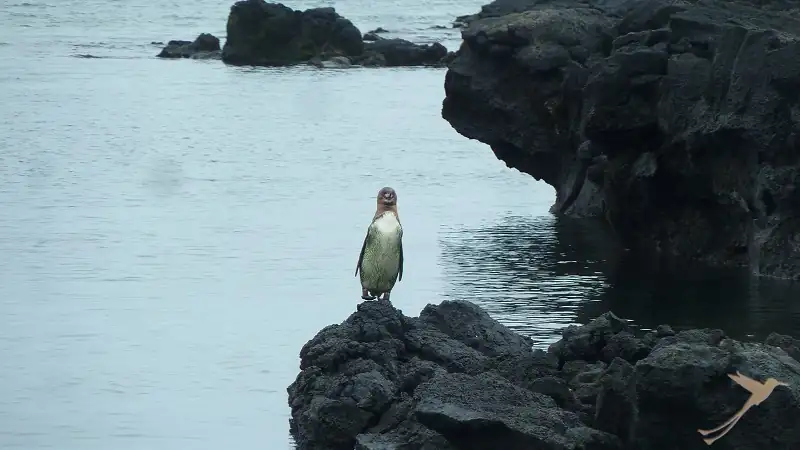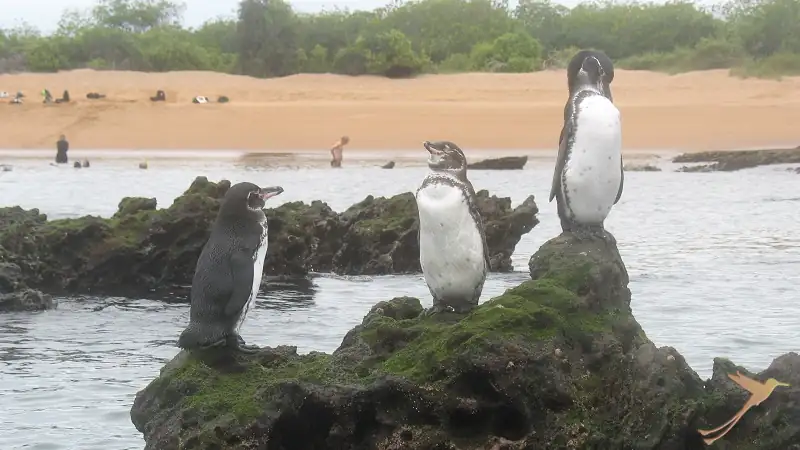Where you can find the Galapagos Penguin

SOLEQMASTER
After some other interesting blog articles, today we continue our series on the amazing flora and fauna of Galapagos. This time it’s about the Galapagos penguin to answer the question: Where you can find the Galapagos Penguin?
Most people know penguins from cold areas like Antarctica. This makes it more amazing for many travelers when they see penguins on the Galapagos Islands. The Galapagos penguins are unique and the only species of penguin that breeds in the northern hemisphere. In this blog article about the extraordinary penguins, read about where exactly you can find them and their characteristic features.
The Galápagos penguin belongs to the genus of spectacled penguins and is found exclusively on the archipelago. It is also one of the rarest penguin species in the world. The size varies between 48 cm and 53 cm with a weight between 1.5 kg and 2.5 kg. Males are heavier than females. Their dorsal plumage is dark, the ventral plumage white, with dark spots sometimes occurring. Characteristic of all spectacled penguins is the white band that runs from the eye to the base of the bill, and another white band around the belly. The bill is black and white, with pink patches of skin at the base, which serve to exchange heat. It is also believed that the beak is crucial in mate selection. The reason for this assumption is that other species of penguins greet each other, but the Galapagos penguin does not, to this extent it is assumed that the beak is important in mate choice. Chicks are light gray to white and slightly lighter around the eyes. They acquire their adult plumage after their first molt, which is the first shedding of their feathers.
Habitat, nutrition and reproduction
Galápagos penguins are found 95 % on the islands of Isabela and Fernandina, with the remainder on the centrally located Santa Cruz Island. Due to the fact that the Galapagos Islands are close to the equator, they are the only penguin species that also breeds in the Northern Hemisphere. Unlike other penguin species, they are not gifted divers; they can stay underwater for only 90 seconds, although they can reach depths of up to 15 meters. However, they mainly stay at depths of up to 3 meters. They feed mainly on small fish, which they catch in groups.
For this purpose, penguins hunt together and eat fish in bays where they cannot escape and flee. They are cavity breeders, and their breeding cycle is irregular, breeding up to three times a year. The irregularity of their breeding cycle is related to the intensity of food gathering. If food is plentiful, the likelihood of another brood increases. The penguins lay two eggs at intervals of 3 to 5 days, which they incubate for about 40 days. During the first three weeks, one parent always stays at the nest to protect the offspring. The little penguins need help in regulating their body temperature, as they cannot control it themselves during the first weeks of life. Often the other parent, who is in charge of food procurement, cannot catch enough food for both chicks, so the malnourished hatchling dies. In the case where both penguin chicks survive, both parents care for the two young about three weeks after birth. After another eight weeks, the penguin young are independent enough to feed on their own.
Endangerment

Galápagos penguins are not only the rarest species on the islands, but are also critically endangered. They have therefore been assigned EN (“endangered”) status on the Red List of Threatened Species. Since 2004, the population, estimated at 1,200 animals, is considered almost stable. Previously, in the 1980s, the number decreased to only 500 specimens, which was related to the eruption of the volcano “El Chico” and the strong El Niño effect. In the El Niño effect, water currents change due to global warming, which can lead to the endangerment of many living creatures.
In addition, the growing pollution of the oceans and the increase in fishing contribute to the threat to the animals. Furthermore, the penguins have many natural enemies such as owls, buzzards, dogs, cats, sharks, orcas, Galápagos sea lions, snakes, and the red cliff crab, which reduce the population.
The Galapagos Islands are an archipelago known for its unique flora and fauna, and its diversity of living creatures was the basis and decisive factor for Charles Darwin’s evolutionary research. The theory of evolution is considered a milestone in scientific research and is still the basis for further investigations. If you would also like to visit the Galapagos Islands, enjoy warm sunshine, swim in the Pacific Ocean and discover different animals and plants, contact us!
We also offer trips to the Andean region, Amazon rainforest and coast of Ecuador and are specialists in organizing tours adapted to your wishes. We will be happy to advise you, inform you about all possible options and make your next vacation unforgettable!

visit our other channels
Recent Posts
- From Manglaralto to Pacoche and surroundings April 18, 2024
- Excursions within the rainforest region of Ecuador April 5, 2024
- Ecuador in a state of emergency?! My personal experience March 22, 2024
- The 10 most beautiful lakes and lagoons in Ecuador – Part 2 March 12, 2024
- The 10 most beautiful lakes and lagoons in Ecuador – Part 1 February 23, 2024